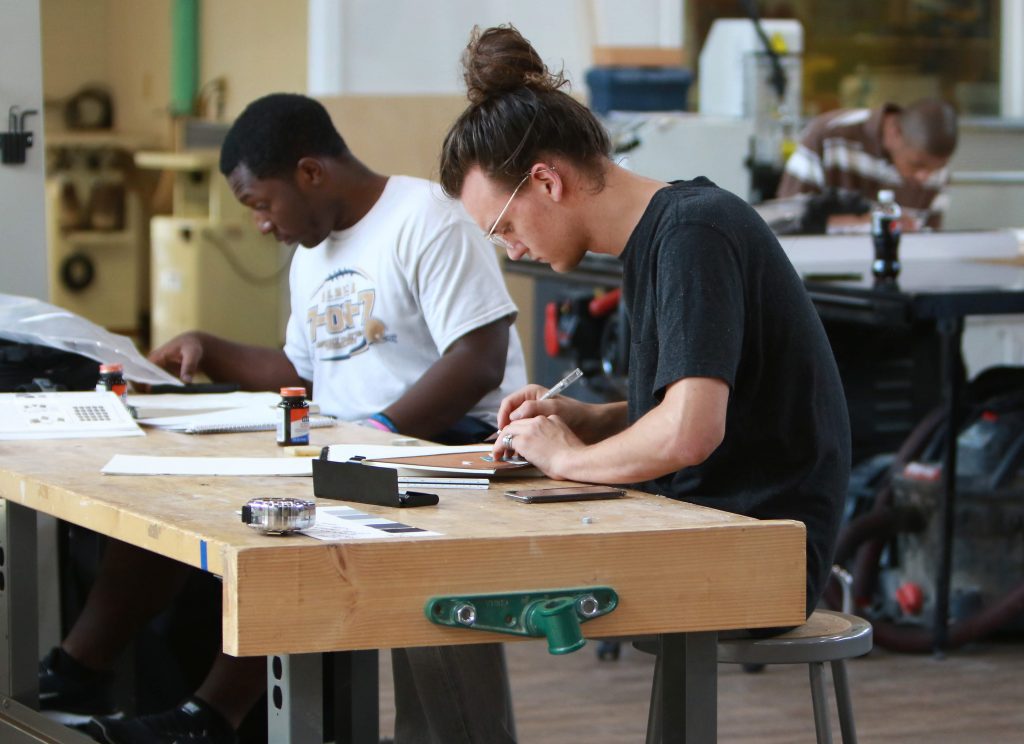Online Bachelor’s in Art & Design (BFA)
Make an Impact Through Your Artistry
Are you ready to fully tap into your creative potential? With an online BFA or BA in Art and Design from Lindenwood University, you can advance your visual artistic expression and bring your artistry to a number of creative settings—from graphic design to animation and illustration and much more!
This 100% online BFA degree lets you choose from emphases in Digital Art, Graphic Design, Photography, and Web and User Experience to help you make the most of your learning and career aspirations. Use your online art degree to help develop your approach to a diversified skill set in areas such as artistic technique, craftsmanship, artistic innovation, project development, and problem solving. Learn at your own pace as you take advantage of an accelerated format that lets you complete your bachelor of arts online in as little as two years!
Program at a Glance
2-4 years
Duration
120
Credit Hours
$495
Cost per Credit
100%
Online
Ranked #4 Most Affordable Online College for Art Degrees
Ranked #5 Most Affordable Online College for Web and User Experience Design Degree
Ranked #7 Most Affordable Online Graphic Design Degree

The BFA in Art and Design with an emphasis in Digital Art provides the format and tools that allow traditional fine arts students to work in digital media. With a firm foundation in the theories and techniques of studio art, digital art majors will be provided the software skills necessary to thrive in the digital art and design industries.
The BFA in Art and Design with an emphasis in Graphic Design covers several areas in design: print and publication, advertising, typography and illustration, web design, user experience, and motion design.
The Bachelor of Fine Arts in Art and Design with an emphasis in Photography prepares students for a variety of careers in the field. Beginning with strong foundational principles of design in related fields, and how to apply them in videography, web design, and more, BFA online students then move on to the advanced study in the field of photography specifically. The online art degree is ideal for students who wish to delve deeply into the field and prepare a professional portfolio to enter into a career directly after graduation. As with the other BFA programs, the emphasis in Photography focuses on creativity, problem solving, project development and teamwork, and mastery of technique and craftsmanship, while providing the interdisciplinary perspective necessary to succeed in today’s art and design fields.
The Bachelor of Fine Arts with an emphasis in Web and User Experience prepares students for a creative career of their choosing. The diverse course offerings in this online design degree allow students to pave their own path towards a career in design, whether it be artistic or technical. By the time they graduate, these students have a varied, in-demand skill set.
The BFA in studio art provides students with a firm foundation in critical theories and trends, as well as the practical application and problem-solving involved in creating works of art. Students in this online art degree are exposed to various approaches in the field, provided with a historical overview of the field, and are introduced to the principles of a wide range of studio disciplines, including painting, sculpture, drawing, printmaking, photography art, and ceramics.
BA vs BFA Degree
The online Bachelor of Arts (BA) degree program is ideal for students who wish to double major or diversify their skills with additional minors and whose educational goal is to major in an art and design program that incorporates a more substantive study in the liberal arts, while the Bachelor of Fine Arts (BFA) online program provides the student the opportunity to learn the basics of art history and theory, while also allowing them to focus their studies on an emphasis area such as photography or graphic design. Both art degree online programs focus on creativity, problem solving, project development, teamwork, and mastery of technique and craftsmanship, while providing the interdisciplinary perspective necessary to succeed in today’s art and design fields.

Course Spotlight
Your online fine arts degree coursework can advance your visual artistry from conceptualization and design to bringing your concept to life in the medium of your choice. The art degree online program immerses you in topics that bridge the classroom with creative industry realities through a focus in areas such as the following:
- Introduction to Art & Design
- Adobe Certifications
- Portfolio Review
- Concentration-specific courses
Career Outlook
Graduates can leverage their visually creative skill sets in fields such as special effects artistry, art direction, graphic design, and more. According to the U.S. Bureau of Labor Statistics (BLS), art directors earn a median annual salary of $100,890. Special effects artists and animators can earn up to $78,790 annually.
Admissions Requirements
For admission to your program, you will need to complete your online application and submit the following documents:
- Online application
- Official transcripts
All colleges and universities previously attended. If you have fewer than 24 college credits, you will need to submit your official high school transcript.
If cumulative college GPA is below a 2.0, the following will also be required:
- Résumé
- Letter of intent/personal statement
(1–2 page document indicating your interest in the program and Lindenwood)
Tuition Details
The cost per credit hour for this program is $495. Besides affordable tuition, we offer a generous transfer policy of up to 90 credits toward your degree completion to further offset tuition costs—to save you time and money on your education!
Frequently Asked Questions
A fine arts degree blends art theory with the practical aspects of artistry, including production and exhibition.
Whether you aspire to producing or supporting fine arts, you can pursue a number of artistic career paths with your online fine arts degree —from graphic design to art gallery management and much more.
Yes, there are scholarships for students comparing arts colleges online programs. Find out if you qualify for a scholarship on the Paying for College page of the website.
Why Choose Lindenwood University Online?
Since 1832, Lindenwood University has served students worldwide with affordable, high-quality academic programs providing real experience and real success. After nearly 200 years of academic excellence, Lindenwood is committed to a set of core values, including integrity, dedication, excellence, creativity, and community.
Quality
We evolve our online degree programs to reflect the latest in academic research and innovation and to meet the top standards of higher education.
Affordability
We are committed to offering our students studying online low tuition rates on top of multiple ways to save on your education.
Career-Focused
Our programs align curriculum to industry realities from experienced instructors who share real-world insights.
Support
We employ experts who are dedicated to helping our students with financial aid planning, enrollment counseling, tutoring services, and more.
We are committed to helping you succeed.
Throughout each step of your online degree program, you will receive support. From enrollment and tuition planning to staying on the right track, your support team is there to ensure your success.
